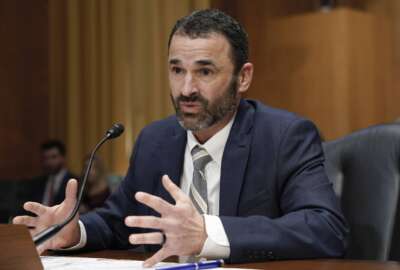Hubbard Radio Washington DC, LLC. All rights reserved. This website is not intended for users located within the European Economic Area.
On Air: Federal News Network
Trending:
Do Not Pay list lacks data as implementation nears
Senate lawmakers are promising to change the laws to let agencies have easier access to the Death Master File and other key databases. Starting June 1, agencies...
wfedstaff | April 17, 2015 4:58 pm
In three weeks, agencies will not be able to cut a check to a contractor or send money to most citizens without first checking the Do Not Pay portal.
But the Do Not Pay website is missing important data, which would help agencies guard against making an improper payment.
The Treasury Department, which runs the Do Not Pay portal, by law can’t access the full Death Master File that is run by the Social Security Administration. 
“Treasury’s long-term vision is to have our Do Not Pay business center and data analytics service to be a robust, timely and flexible service for agencies to use in identifying and preventing waste, fraud and abuse,” said Richard Gregg, Treasury’s fiscal assistant secretary Wednesday. “To fully achieve this vision, Treasury will work to both improve the quality and the availability of data as well as strengthen our analytics capability. The key issue for Do Not Pay is access to data.”
And it’s not just the Death Master File that Treasury doesn’t have access to. Gregg said the prisoner database and the National Directory of New Hires also isn’t included in the Do Not Pay list.
Other data sharing challenges
In other cases, Treasury can obtain access to other data sources through computer matching agreements. Gregg said that is not the preferred approach.
“I think steps were taken in Improper Payments Elimination and Recovery Act to help with computer matching. If further refinement could make that even easier, that would streamline the process,” Gregg said. “Having gone through it numerous times, it’s onerous to get the agreements and even though there are some deadlines set in that, further improvements would help.”
The data issue is so challenging that even agency inspectors general want an exception from the data matching law.
Danny Werfel, the Office of Management and Budget’s controller, said some of the current laws are so onerous that the government sometimes looks to the private sector for information first because it’s easier to obtain the data it needs as opposed to going to the government source.
President Barack Obama required the development of the Do Not Pay portal in a 2010 memo. OMB reinforced the importance of the Do Not Pay list in 2012 with a second memo that required agency chief financial officers to develop a plan to implement the tool.
More support from Congress
The lack of access to key databases is not a new problem. Werfel and other agency leaders have asked Congress for help before. During a 2012 hearing before the Senate Homeland Security and Governmental Affairs subcommittee, Werfel called for access to the Master Death File as well as the need to change the computer matching programs provisions in the 1988 amendments to the Privacy Act of 1974.
The difference this time before the full committee is lawmakers are promising to change the law.
Sens. Tom Carper (D-Del.) and Tom Coburn (R-Okla.), chairman and ranking member of the committee, respectively, said they’d seriously consider the administration’s proposals to access data and make it easier for agencies to stop and recover improper payments.
“I have directed my staff to take the recommendations from the budget and as fast as possible get that into legislative language,” said Coburn said. “We will find a broad range of bipartisan support for actually making these changes.”
Coburn said he wants to hear from the agencies on how to reduce the complexity of sharing information. Currently, SSA works with the Commerce Department to make a lesser version of the Death Master File available to a broader audience.
“This shouldn’t have to go from you to Commerce; Commerce to National Technical Information Service, and NITS to everyone else,” Coburn said. “It ought to be here is what it costs. If there is a charge, it ought to go straight to Social Security and go to all the rest of them so we clean up the steps in terms of getting this information available.”
Striking the right balance
The 2014 budget request included several proposals, including moving funding for the Department of Health and Human Services and SSA to address improper payments from the discretionary to the mandatory side. 
“We’ve worked hard to strike a balance here because we want to make sure federal agencies have access to this data to prevent improper payments via the Do Not Pay list and we also want to make sure law enforcement has access to the data,” said Marianna LaCanfora, the acting deputy commissioner for retirement and disability policy at SSA. “Through this proposal, we want to expand federal agency access, but at the same time, we’re also delaying the release of the public Death Master File for three years because there are criminals out there using that data to commit tax fraud. We want to prevent that.”
She said six agencies have access to the full master death file, including HHS, the Centers for Medicaid and Medicaid Services and the Defense Department. SSA also is in discussions with two agencies more to begin paying for data.
Under the law, SSA is required to charge for the data. LaCanfora said agencies pay anywhere from $9,000 to $45,000 a year depending on the amount of data they are receiving and whether the customer agency is providing SSA any data in return.
The Death Master File is far from perfect.
The Government Accountability Office is in the middle of a study and found records of 1,300 people where the listed age of beneficiaries of death was between 111- years old and 129-years old. Additionally, GAO found records of 1,800 people who had Social Security numbers but died prior to the year SSNs came into existence.
Growing list of users
Even without access to the Master Death File, agencies are using the Do Not Pay portal.
Treasury’s Gregg said 36 agencies and nine states that administer federal funds are taking advantage not only of the data but also of the analytical services.
The portal does include information from a host of databases including debarred contractors, individuals who owe child support or non-tax debt and other sources.
Gregg said data is important, but it’s also about how data is used.
“Treasury also is working to improve its data analytics service. Improving data quality will provide agencies with reliable results and minimize false positives,” Gregg said. “In the long term, Treasury is working to develop a forward looking, continuous monitoring fraud identification tool. Treasury also will enhance Do Not Pay to provide a feedback loop so that agencies can improve their own data, basically a continuous learning process.”
RELATED STORIES:
Legislative changes need to make bigger dent in improper payments
White House tells agencies to use data analysis to reduce improper payments
White House unveils new tool to stop improper payments
Copyright © 2024 Federal News Network. All rights reserved. This website is not intended for users located within the European Economic Area.
Jason Miller
Jason Miller is executive editor of Federal News Network and directs news coverage on the people, policy and programs of the federal government.
Follow @jmillerWFED
Related Topics
Acquisition
All News
Congress
Contracts/Awards
Danny Werfel
Death Master File
Financial management
Improper payments
Information sharing
Management
Office of Management and Budget
Senate Homeland Security and Governmental Affairs Committee
Social Security Administration
Technology
Tom Carper
Tom Coburn
Treasury Department





